Korfball drills for technique attack / score
By 3 at a basket.
Step 1:
Step 1:
- Player Red defends Player Blue.
- Player Blue has the ball and then throws it to Player White and runs deep and shoots.
Step 2:
- Follow Step 1 and after Player Blue runs deep, Player White rushes in for a giveaway.
- Player Blue goes for a pass through Blue.
- Player Red continues to defend, but allows the through ball.
Take the goal attempts as calmly as possible
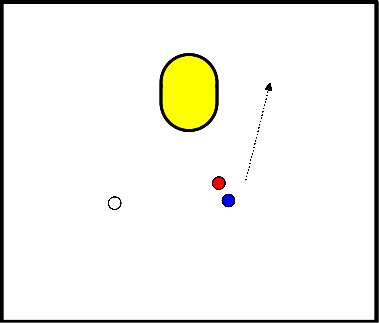
Circuit training where one station is rotated through every 2 minutes.
Possibly adjust assignments to number of players.
At each station, shoot from a different spot to score. Per 2-team.
Examples for distances:
Possibly adjust assignments to number of players.
At each station, shoot from a different spot to score. Per 2-team.
Examples for distances:
- 2.5 meters in front of the post.
- 2.5 meters behind the post.
- Distance shot.
- Side shots.
- Top-handed through-balls.
- Underhanded through-balls.
- Player A starts with the ball 2.5 meters diagonally in front of the post. Player B also stands 2.5 meters diagonally in front of the post.
- Player A throws the ball to player B and player B throws it back. Thus they bring the ball up to about 8 meters in front of the post.
- From there, player B starts for a through ball from the space indicated by player A.
- However, instead of player B taking the through ball, it now enters the declarer and player A comes in for a clearance ball. Player B catches the ball.
A variation on this:
Only throw the ball when player B runs next to/behind the basket and player B immediately makes a shot. Player A immediately runs in to catch the ball.
Only throw the ball when player B runs next to/behind the basket and player B immediately makes a shot. Player A immediately runs in to catch the ball.
There are more variations on this, such as:
- Most goals in a time frame of, say, 10 minutes
- Who scores 10 goals first
- Make it more difficult by deducting a point for each ball on the ground.
- Possibly with a 3rd player to rotate and keep a slightly slower pace.
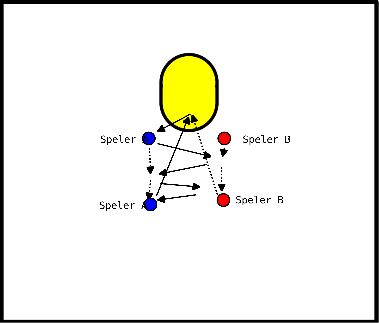
- Player A starts with the ball 2.5 meters diagonally in front of the post.
- Player B also stands 2.5 meters diagonally in front of the post.
- Player A throws the ball to player B and player B throws it back.
- Thus they bring the ball up to about 8 meters in front of the post.
- From there player B starts for a through ball from the space indicated by player A.
- Player A also runs in after it to catch the ball before it bounces on the ground.
Variations:
- Most goals in a 10-minute time frame.
- Whoever gets to 10 goals first.
- Make it harder by taking a point off every ball on the ground.
- Possibly with a 3rd person there to rotate through and keep a slightly slower pace.
- Most goals in a 10-minute time frame.
- Whoever gets to 10 goals first.
- Make it harder by taking a point off every ball on the ground.
- Possibly with a 3rd person there to rotate through and keep a slightly slower pace.
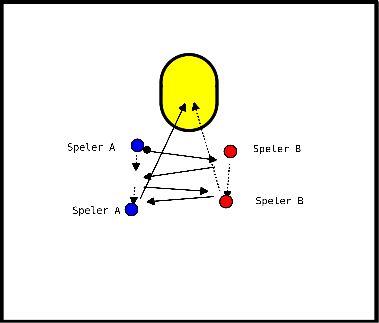
- Per person, everyone must score 10 through balls, this goes in groups of 3 or 4.
- In case of a miss, the whole group goes to the other side of the field on pace run and back.
- The one who missed takes the chance again.
- Until 10 are scored per player.
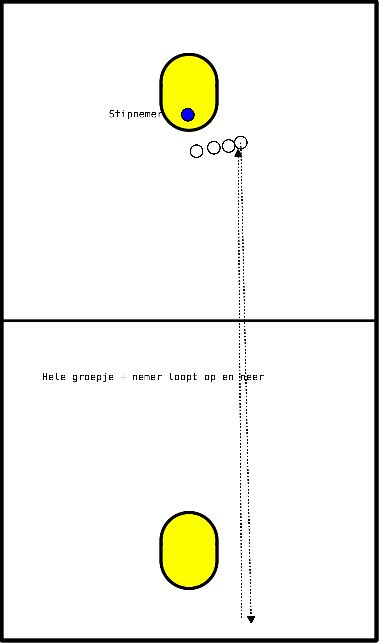
Goal: defend your own basket but score at another. Whoever remains last wins.
Minimum 3 groups of 2.
Maximum 5 groups of 3 or 4 groups of 4.
Minimum 3 groups of 2.
Maximum 5 groups of 3 or 4 groups of 4.
- Each group has a basket.
- Number of balls depends on how many groups. For example, 3 groups 2 balls.
- Make easier by fewer balls and larger groups.
- the back player cuts in to the support as the ball enters the field and gets it played.
- the passer simultaneously runs across the support to the rebound and takes over.
- the support passes the ball to the diagonal player in the break and takes the shot
- If that is not successful, the ball can be passed to the outgoing first rebounder
At that point, there can be doubles/ breakthroughs from both the first and second players and you get opportunities again if the then standing rebounder steps out again or the earlier support makes an action without the ball.
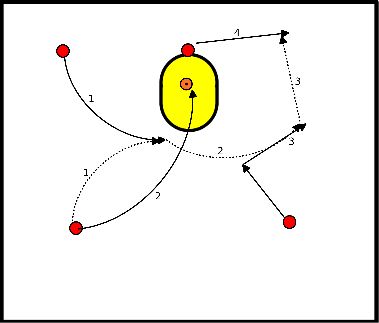
- The first ball is played deep from the front pocket.
- Then the other front comes in and passes the ball.
- The first passer runs across the block to the catch.
- The adjuster runs on the ball side for a through ball to the post.
Alternatively, the ball is played back directly for the distance shot. - The player under the post steps out as soon as the rebound is taken over from the front and ensures that the player with the ball has two points of attack.
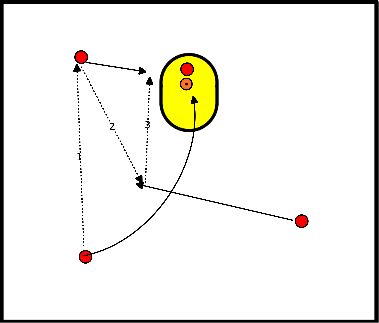
- This exercise is designed to let the players choose for themselves what they want to improve on.
- Which (improvement) goal, which they have set for themselves, do they want to improve here.
- As a trainer you can steer this by guiding the choice.
- For example: the exercise must have something to do with passing/shooting/attacking/looking etc.
A small square around the basket. In this square, 2 players must continuously attack and pass. After each pass the player is in motion.
- 2 Run after passing. After 4 ball touches the shot follows and the other one catches it (shoot to score, not because you are free).
- 3 Crossing after passing.
- After each pass, the thrower crosses with the player who did not receive the ball and they swap positions. After crossing, the ball goes to one of the two and the other one catches it.
- 3/1 Same as above but make sure that, as soon as you receive the ball, you are ready to shoot. If you are in a good position and have caught the ball well, you may shoot, otherwise you play on and the next player shoots.
- 4 All of the above actions but now with a good rebound, but this one does not stay in position.
6 at the basket:
- Defenders give pressure, but allow the shot.
- By moving and playing together as close to the basket as possible, the players create a good opportunity.
- Rotation is done when: a goal is scored or the defender has the ball.
Change positions after 2 attacks, any other players take penalties on another post. Then swap often.
Adjust:
- Move well after passing, free movement prevails over rebound --> dynamic
- Turn in time for the shot.
- Emphasize that every pass should result in an opportunity, so no pointless doubling.
- Shoot to score, do not throw to throw
- Prepare good shots, also close to the basket (do not take short chances nonchalantly).
After a while, make it more difficult:
- After each pass you must cross with the other player who is not in possession of the ball.
- Afterwards, you can leave the crossing out, and give the opportunity to run in support from the space.
5 players at the basket:
- By moving and playing together as close to the basket as possible to get a good opportunity
- Rotation is done when: a goal is scored, the defender has the ball or when the ball bounces.
Move forward in sequence A-A-A-V-V. The remaining players take short chances at a different post. Alternate often.
Adjusting:
- Move well after passing, free movement prevails over rebound --> dynamic
- Turn in time before shooting
- Shoot to score, do not throw to throw
- Finish your shot preparations well, also close to the basket (do not take short chances).
After a while, make it more difficult:
- After each pass you must cross with the other player who is not in possession of the ball







